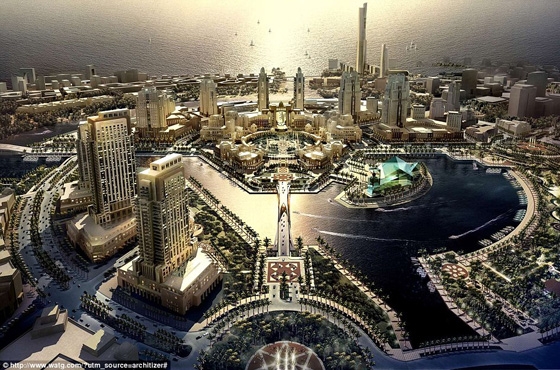Saudi Arabia is pushing ahead with plans to complete building work on a new megacity in the desert.
The King Abdullah Economic City, or KAEC (pronounced 'cake'), will be slightly larger than Washington DC and home to approximately two million residents. Covering 70 square miles, the metropolis is costing £67 billion ($100 billion) and lies 100km from Jeddah, the commercial hub of the kingdom, near the Red Sea.
The late king had pinned his hopes for his country's future on the new-build, although at the moment it resembles a dusty building site dotted with cranes and work is not likely to be completed for ten years, at least.
So far 15 per cent has been built, as public facilities and residential areas are still under construction. Plans include a port, industrial complex, a financial island, beach facilities and residential neighborhoods.
KAEC is one of four new cities being built to diversify an economy that is overly dependent on oil. Already it has its own website showing plans, maps and including details on how to invest.
Fadi Al-Rasheed, the managing director of Emaar Economic City, the publicly traded Saudi company that runs the entire KAEC project, told the BBC: 'We're building with the 65 per cent of the population who are under 30 in mind,' he explains. 'And we have almost 200,000 Saudis studying abroad. Inevitably they are going to change things when they come back.'
Given that more women than men graduate from university, it is likely the Saudi landscape will shift over the coming years in more ways that one.
There are 90 km of roads in use in KAEC but, under present deeply held religious beliefs prohibiting it, no women in the country are able to drive on them.
The city's future hinges on many things including the complex relationships between health, education, housing and employment requirements and infrastructure.
It will also open up transport links around the kingdom and internationally.
'We aim to create one of the world's largest ports,' Rayan Bukhari, a young manager at the King Abdullah port told the BBC.
'We're not competing with Jeddah's Islamic port – but we are going to take business away from Jebel Ali in Dubai. That's because of our quicker, more automated offloading and customs procedure.'
'Freight arriving at the port will be taken directly to the capital via the new land bridge,' he says, 'At the moment lots of products destined for Riyadh are shipped to Dubai, but that will change. They'll be shipped here as it is cheaper – and can be delivered more quickly within the Kingdom.'
KAEC is also expected to become an important tourist stopover for pilgrims, aided by the fact Mecca and Medina are on the high speed train network that links KAEC with the two holy cities.
At the moment Mecca is one hour and twenty minutes drive away and Medina is three hours by car.
The Haramain train station will open at the end of this year and has been designed by British architect Norman Foster, also the man behind London's 'Gerkin' skyscraper and New York's Hearst Tower.
The station will provide acceleration to area's developmental plan and will reduce the journey to Jeddah to 30 minutes. The megaproject on KAEC was announced in 2005.
The project is largely privately funded and the government has set up an Economic Cities Authority overseeing the four megacities able to deal swiftly with every licence, construction permit and approval needed.
Daily Mail
22 March






















































